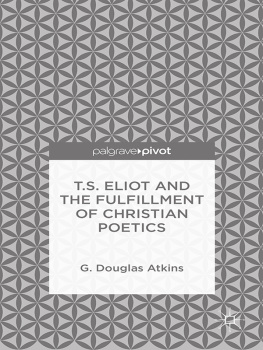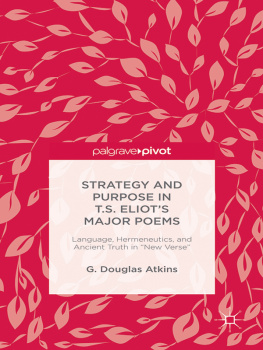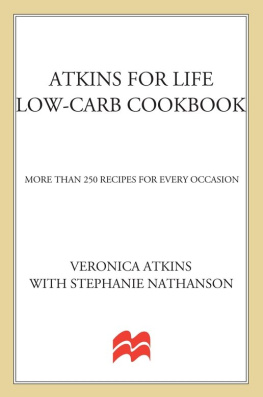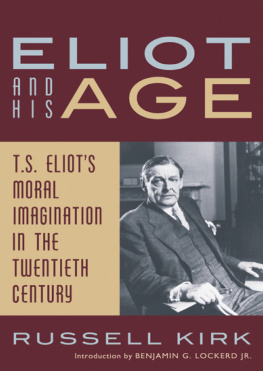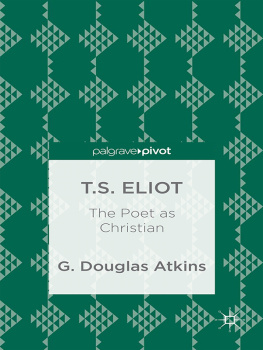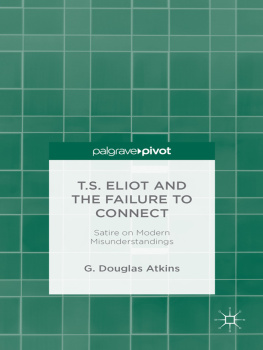Atkins G. Douglas - T.S. Eliot Materialized: Literal Meaning and Embodied Truth
Here you can read online Atkins G. Douglas - T.S. Eliot Materialized: Literal Meaning and Embodied Truth full text of the book (entire story) in english for free. Download pdf and epub, get meaning, cover and reviews about this ebook. City: Basingstoke, year: 2013, publisher: Palgrave Macmillan, genre: Romance novel. Description of the work, (preface) as well as reviews are available. Best literature library LitArk.com created for fans of good reading and offers a wide selection of genres:
Romance novel
Science fiction
Adventure
Detective
Science
History
Home and family
Prose
Art
Politics
Computer
Non-fiction
Religion
Business
Children
Humor
Choose a favorite category and find really read worthwhile books. Enjoy immersion in the world of imagination, feel the emotions of the characters or learn something new for yourself, make an fascinating discovery.
- Book:T.S. Eliot Materialized: Literal Meaning and Embodied Truth
- Author:
- Publisher:Palgrave Macmillan
- Genre:
- Year:2013
- City:Basingstoke
- Rating:3 / 5
- Favourites:Add to favourites
- Your mark:
- 60
- 1
- 2
- 3
- 4
- 5
T.S. Eliot Materialized: Literal Meaning and Embodied Truth: summary, description and annotation
We offer to read an annotation, description, summary or preface (depends on what the author of the book "T.S. Eliot Materialized: Literal Meaning and Embodied Truth" wrote himself). If you haven't found the necessary information about the book — write in the comments, we will try to find it.
T.S. Eliot Materialized: Literal Meaning and Embodied Truth — read online for free the complete book (whole text) full work
Below is the text of the book, divided by pages. System saving the place of the last page read, allows you to conveniently read the book "T.S. Eliot Materialized: Literal Meaning and Embodied Truth" online for free, without having to search again every time where you left off. Put a bookmark, and you can go to the page where you finished reading at any time.
Font size:
Interval:
Bookmark:
T.S. Eliot Materialized
Also by G. Douglas Atkins
THE FAITH OF JOHN DRYDEN: Change and Continuity
READING DECONSTRUCTION/DECONSTRUCTIVE READING
WRITING AND READING DIFFERENTLY: Deconstruction and the Teaching of Composition and Literature (co-edited with Michael L. Johnson)
QUESTS OF DIFFERENCE: Reading Popes Poems
SHAKESPEARE AND DECONSTRUCTION (co-edited with David M. Bergeron)
CONTEMPORARY LITERARY THEORY (co-edited with Laura Morrow)
GEOFFREY HARTMAN: Criticism as Answerable Style
ESTRANGING THE FAMILIAR: Toward a Revitalized Critical Writing
TRACING THE ESSAY: Through Experience to Truth
READING ESSAYS: An Invitation
ON THE FAMILIAR ESSAY: Challenging Academic Orthodoxies
LITERARY PATHS TO RELIGIOUS UNDERSTANDING: Essays on Dryden, Pope, Keats, George Eliot, Joyce, T.S. Eliot, and E.B. White
T.S. ELIOT AND THE ESSAY: From The Sacred Wood to Four Quartets
READING T.S. ELIOT: Four Quartets and the Journey toward Understanding
E.B. WHITE: The Essayist as First-Class Writer
SWIFTS SATIRES ON MODERNISM: Battlegrounds of Reading and Writing (forthcoming)

T.S. Eliot Materialized:
Literal Meaning and
Embodied Truth
G. Douglas Atkins


T.S. ELIOT MATERIALIZED
Copyright G. Douglas Atkins, 2013.
All rights reserved.
First published in 2013 by
PALGRAVE MACMILLAN
in the United Statesa division of St. Martins Press LLC,
175 Fifth Avenue, New York, NY 10010.
Where this book is distributed in the UK, Europe and the rest of the world, this is by Palgrave Macmillan, a division of Macmillan Publishers Limited, registered in England, company number 785998, of Houndmills, Basingstoke, Hampshire RG21 6XS.
Palgrave Macmillan is the global academic imprint of the above companies and has companies and representatives throughout the world.
Palgrave and Macmillan are registered trademarks in the United States, the United Kingdom, Europe and other countries.
ISBN: 9781137301338 EPUB
ISBN: 9781137301321 PDF
ISBN: 9781137301314 Hardback
Library of Congress Cataloging-in-Publication Data is available from the Library of Congress.
A catalogue record of the book is available from the British Library.
First edition: 2013
www.palgrave.com/pivot
DOI: 10.1057/9781137301321
Contents
Preface and Acknowledgments
T.S. Eliot Materialized is not, of course, a materialist or historicist reading of the royalist, Anglo-Catholic, and classicist poet, essayist, and dramatist. It is not, in fact, strictly speaking, a reading. Rather, it is an essay toward literal reading made up of chapters mirroring in thematic discovery the way of reading that Eliot himself embraced and appears to have wanted. Also about separation and healing union, the book you hold or screen reveals Old Possums reiterated desire to amalgamat[e] disparate experience. With recourse to Incarnational patterning even before he converted to Anglo-Catholicism in 1927, Eliot declined to engage in simple either/or choices; instead, for him, the letter, for example, is the spirit embodied.
I am thus challenging the familiar deep reading of Eliot, which often entails the search for hidden meanings and prizes symbols for their richness and difficulty. I also challenge the familiar, indeed perennial notion that Eliot, before and after conversion, was an idealist, really a pur-itan, fundamentally hankering to escape from time and the so-called real world for a transcendent and pure world of ideas and spirit. Readers have, unfortunately, been trained to miss his commitment to the physical, tangible, sensory world, in part because they fail to understand Incarnation. Eliot begins from the physical and the literal and proceeds in, through, and by means of it to the spiritual; he is thus neither immersed in the physical nor willing ever to leave it behind. In this, he follows such luminaries as Lancelot Andrewes (and before him, Saint Anselm).
A labor of love, this little book follows from my earlier books on Eliot (T.S. Eliot and the Essay and` Reading T.S.Eliot), in both of which the great essay-poem Four Quartets took center-stage. Here that poem has receded, perhaps, into the background, though it retains some importance, serving, I might say, as mediator as well as Magister. In treating the letter and the spirit, this book partners with my recent study of Swift and modern inwardness and subjectivity. It may, of course, be read singly, alone, and with profit, or so I trust, by specialist and nonspecialist reader alike.
I happily acknowledge my debts to Old Possum himself; his previous readers, particularly Elizabeth Drew, Dame Helen Gardner, and Hugh Kenner; and my teachers, especially Vincent E. Miller (Wofford College), who introduced me to Eliot and who taught me to read by asking questions of a text; Irvin Ehrenpreis (University of Virginia), who showed me the way to proceed in, through, and by means of eighteenth-century studies to twentieth-century ones; and Geoffrey Hartman (School of Criticism and Theory, University of California, Irvine), who showed me all about reader-responsibility.
I owe a special debt here to Brigitte Shull, senior editor at Palgrave Macmillan, who invited me to contribute to the new Palgrave Pivot series. Her invitation prompted this essai. This is my fifth, and, I hope, not last, book with Palgrave Macmillan. Working with Brigitte, whom I still have not met or spoken with on the phone, has been a pleasure and a profit. As has working with Erin Ivy, senior production manager, whose efficiency, skill, and acumen I wish I could say she took from me when she was my student. But, alas, Erin is alone responsible for her consummate capaciousness. I also owe a great deal to the anonymous reviewer of the manuscript, who provided much-needed support and offered acute suggestions for improvement. I hope I have not disappointed that reader. I thank again Lori Whitten, Paula Courtney, and Pam LeRow, who assisted in so many ways, always with grace and good cheer.
Last, but not least, I thank, once more, my daughter Leslie, her husband Craig, my granddaughter Kate, my son Christopher, his wife Sharon, my grandson Oliver, my wife Rebecca, and our child, the wonderful Millicent Bofort Black-n-Bonny, reminders, each and every one of them, that every moment is attended. No one mentioned in this preface, or unmentioned, bears any responsibility for my mishaps or missteps; for them, alas, I alone am responsible.

Reading Literally, Reading Laterally
Abstract:Much of T.S. Eliots undeniable difficulty stems, not from inherent obscurity, but from the way we have been taught to read the poetry. He himself famously said that modern poetry must be difficult, and his is demanding: allusive, indirect, often following what he called the logic of the imagination. Rather than continue to read him in depth, with special attention to symbols and allusions, it is time to follow the lead of the poetry itself, and read it literally and laterally. Eliot practiced a comparative style of reading, and his own poetry calls for reading that juxtaposes passages within a given poem and between and among his poems. The words themselves are the means by which the Word is approached.
Next pageFont size:
Interval:
Bookmark:
Similar books «T.S. Eliot Materialized: Literal Meaning and Embodied Truth»
Look at similar books to T.S. Eliot Materialized: Literal Meaning and Embodied Truth. We have selected literature similar in name and meaning in the hope of providing readers with more options to find new, interesting, not yet read works.
Discussion, reviews of the book T.S. Eliot Materialized: Literal Meaning and Embodied Truth and just readers' own opinions. Leave your comments, write what you think about the work, its meaning or the main characters. Specify what exactly you liked and what you didn't like, and why you think so.


